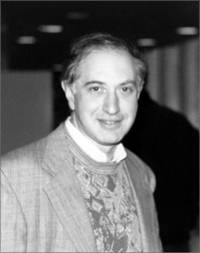| REGISTRATION LIST |
| Name |
Affiliation |
E-mail |
Talk / Poster |
| 1. Aurora Tumino |
LNS-INFN, Italy |
tumino@lns.infn.it |
Light
nuclear clusters to look into the bright stars |
| 2. Stuart Pittel |
University of Delaware, USA |
pittel@bartol.udel.edu |
Shape transition from vibrational to axially deformed nuclei in the nucleon pair shell model |
| 3. Norbert Pietralla |
TU Darmstadt, Germany |
pietralla@ikp.tu-darmstadt.de |
The beauty of good data:
unveiling the traces of mixed symmetry |
| 4. Peter Hess |
ICN-UNAM, Mexico |
hess@nucleares.unam.mx |
The geometric interpretation of the Semimicroscopic Algebraic Cluster Model and the role of the Pauli principle |
| 5. Jorge G Hirsch |
ICN-UNAM, Mexico |
hirsch@nucleares.unam.mx |
Algebraic nuclear mass formulas |
| 6. Valeriy Dvoeglazov |
UAF-UAZ, Zacatecas, Mexico |
vdvoeglazov@yahoo.com.mx |
How to construct self/anti-self charge conjugate states for higher spins? |
| 7. Ruslán Magaña Vsevolodovna |
UJAT, Tabasco, Mexico |
ruslan_mv@mail.ru |
Correlations between two-nucleon transfer reactions in
the context of nuclear supersymmetry |
| 8. Joseph Ginocchio |
Los Alamos National Lab, USA |
gino@lanl.gov |
Relativistic Symmetries in Nuclei |
| 9. Kurt Bernardo Wolf |
ICF-UNAM, Morelos, Mexico |
bwolf@fis.unam.mx |
Linear canonical transforms: 40 years of developments |
| 10. Baha Balantekin |
University of Wisconsin, USA |
baha@physics.wisc.edu |
Symmetries of Neutrino Interactions |
| 11. Yoram Alhassid |
Yale University, USA |
yoram.alhassid@yale.edu |
Signatures of nuclear phase transitions at finite excitation energies |
| 12. Egle Tomasi Gustafsson |
Institut de Physique
Nucleaire, France |
etomasi@cea.fr |
Symmetries and Hadron Form Factors |
| 13. Richard Casten |
Yale University, USA |
richard.casten@yale.edu |
A mini-Wigner effect in p-n interactions in heavy nuclei and the 0[110] transformation in the Nilsson scheme |
| 14. Jerry Draayer |
Louisiana State
University, USA |
draayer@lsu.edu |
Symmetry
adapted open-core theory for light nuclei - 12 C and
16 O |
| 15. Piet Van Isacker |
GANIL, France |
isacker@ganil.fr |
Nuclear charge radii and E0 transitions in the IBM |
| 16. R. Burcu Cakirli |
MPIK-Heidelberg, Germany &
Istanbul University, Turkey |
rburcu@mpi-hd.mpg.de |
Relation of Masses and Spectroscopic Observables to Structure |
| 17. Amiram Leviatan |
Hebrew University, Israel |
ami@phys.huji.ac.il |
From Exact to Partial Dynamical Symmetries: Lessons From the Interacting Boson Model |
| 18. Ani Aprahamian |
University of Notre Dame, USA |
aapraham@nd.edu |
Nuclear
structure: sensitivity of the r-process to masses,
decay rates and cross sections |
| 19. Danielle Larese |
Yale University, USA |
danielle.larese@yale.edu |
Quantum
monodromy and quantum phase transitions in floppy molecules |
| 20. Jenni Kotila |
Yale University, USA |
jenni.kotila@yale.edu |
Advances
in the calculation of double beta decay |
| 21. Moshe Gai |
Yale and UConn, USA |
moshe.gai@yale.edu |
The
Structure of the Hoyle State and its Partner 2+ State
in 12 C |
| 22. Andrea Vitturi |
Padova, Italy |
vitturi@pd.infn.it |
Pairing correlations and two-particle transfer reactions |
| 23. Pedro Pérez Fernández |
Sevilla, Spain |
pedropf@us.es |
Excited
state quantum phase transitions and chaos in the
Dicke model |
| 24. Tobias Kramer |
Universität
Regensburg, Germany |
tobias.kramer@mytum.de |
Interacting few body-systems in magnetic fields |
| 25. Francesco Iachello |
Yale University, USA |
francesco.iachello@yale.edu |
Beauty in Nature: symmetry in art and science |
| 26. Maia Angelova |
Northumbria University, UK |
maia.angelova@northumbria.ac.uk |
Algebraic models and
squeezed coherent states of anharmonic oscillators |
| 27. Mark Caprio |
University of Notre Dame, USA |
mcaprio@nd.edu |
Generalized
seniority for the shell model with realistic interactions |
| 28. Jolie Cizewski |
Rutgers University, USA |
cizewski@physics.rutgers.edu |
Single-neutron
excitations near 132 Sn |
| 29. Margarita Man'ko |
Lebedev Physical Institute, Russia |
mmanko@sci.lebedev.ru |
Entropic
uncertainty relations in the tomographic probability representation |
| 30. Vladimir Man'ko |
Lebedev Physical Institute, Russia |
manko@sci.lebedev.ru |
Probability
as a basic notion of physical system states, quantum
and classical |
| 31. Kosuke Nomura |
Universität zu
Köln, Germany |
nomura@ikp.uni-koeln.de |
Interacting
boson model from microscopic theory |
| 32. Achim Richter |
Darmstadt, Germany and ECT*, Italy |
richter@ectstar.eu |
Beautiful
graphene, photonic crystals, Schrödinger and
Dirac billiards and their spectral properties |
| 33. Olaf Scholten |
KVI, The Netherlands |
scholten@kvi.nl |
The
moon as a detector of Ultra-High-Energy neutrinos |
| 34. Jouni Suhonen |
University of Jyväskylä, Finland |
jouni.suhonen@phys.jyu.fi |
Exotic
weak decays of atomic nuclei |
| 35. Akito Arima |
Tokyo, Japan |
arima@musashi.jp |
A new method for diagonalization of Hamiltonians with large dimensions |
| 36. José Barea |
Universidad de Concepción, Chile |
jbarea@udec.cl |
Present
status of the double-beta decay calculations within
the microscopic Interacting Boson Model |
| 37. Jonathan Engel |
UNC, USA |
engelj@physics.unc.edu |
Group theory for testing
calculations of double beta decay |
| 38. Roelof Bijker |
ICN-UNAM, Mexico |
bijker@nucleares.unam.mx |
Configuration
mixing in the quark model |
| 39. Alejandro Frank |
ICN-UNAM, Mexico |
frank@nucleares.unam.mx |
Time
series and their applications to physics and biology |
| 40. Elizabeth Padilla |
ICN-UNAM, Mexico |
padilla@nucleares.unam.mx |
Nuclear
structure studies at an ISOL facility |
| 41. Giuseppe Galatà |
ICN-UNAM, Mexico |
giuseppe.galata@nucleares.unam.mx |
Diquarks
in hadron spectroscopy |
| 42. Peter Ring |
TU München, Germany |
ring@ph.tum.de |
Microscopic description
of quantum phase transitions in nuclei |
| 43. Shalom Shlomo |
Texas A & M, USA |
shlomo@comp.tamu.edu |
Current status of the
equation of state of nuclear matter |
| 44. Lorenzo Fortunato |
Padova, Italy |
fortunat@pd.infn.it |
Symplectic
spectrum generating algebra for three-body models |
| 45. Calvin Johnson |
SDSU, USA |
cjohnson@sciences.sdsu.edu |
The origin of order in
random matrices with symmetries |
| 46. Jorge Dukelsky |
CSIC, Spain |
dukelsky@iem.cfmac.csic.es |
Integrable
Richardson-Gaudin models in nuclear physics |
| 47. Pavel Stránský |
ECT*, Italy |
stransky@ectstar.eu |
Order
to chaos transition in the geometric collective model
using geometric criteria |
| 48. Mariana Kirchbach |
UASLP, Mexico |
mariana@ifisica.uaslp.mx |
Algebra
preserving metric deformation of a conformal group
manifold and degeneracies in hadron spectra |
| 49. José Enrique García-Ramos |
Huelva, Spain |
enrique.ramos@dfaie.uhu.es |
Decoherence
and quantum quench: the relationship with excited
state quantum phase transitions |
| 50. Francisco Pérez-Bernal |
Huelva, Spain |
francisco.perez@dfaie.uhu.es |
Coupled
molecular benders modeling within the vibron model 2D limit |
| 51. Mauro Giannini |
Genova, Italy |
mauro.giannini@ge.infn.it |
The
hypercentral constituent quark model |
| 52. Elena Santopinto |
Genova, Italy |
elena.santopinto@ge.infn.it |
Unquenching
the quark model |
| 53. Jacopo Ferretti |
ICN-UNAM, Mexico |
jacopo.ferretti@ge.infn.it |
Relativistic
quark-diquark model of baryons |
| 54. Lex Dieperink |
KVI, The Netherlands |
dieperink@kvi.nl |
|
| 55. Miguel Ángel
Bastarrachea Magnani |
ICN-UNAM, Mexico |
mamigre4008@gmail.com |
Convergence
in numerical solutions of the Dicke Hamiltonian |
| 56. Mirshod Ermamatov |
ICN-UNAM, Mexico |
mirshod.ermamatov@nucleares.unam.mx |
Excited
state properties of deformed 176,177 Hf nuclei |
| 57. Praveen Srivastava |
ICN-UNAM, Mexico |
praveen.srivastava@nucleares.unam.mx |
Large-scale
shell model calculations for 32-39 P isotopes |
| 58. Octavio Castaños |
ICN-UNAM, Mexico |
ocasta@nucleares.unam.mx |
Matter-field
entanglement within the Dicke model |



